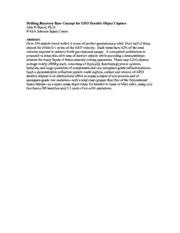
NASA Technical Reports Server (NTRS) 20090039992: Drifting Recovery Base Concept for GEO Derelict Object Capture PDF
Preview NASA Technical Reports Server (NTRS) 20090039992: Drifting Recovery Base Concept for GEO Derelict Object Capture
Drifting Recovery Base Concept for GEO Derelict Object Capture John B Bacon, Ph.D. NASA Johnson Space Center Abstract: Over 250 objects hover within 6 m/sec of perfect geostationary orbit. Over half of these objects lie within 0.1 m/sec of the GEO velocity. Such items have 62% of the total velocity required to achieve Earth gravitational escape. A conceptual architecture is proposed to clean this orbit area of derelict objects while providing a demonstration mission for many facets of future asteroid mining operations. These near-GEO objects average nearly 2000kg each, consisting of (typically functioning) power systems, batteries, and large quantities of components and raw aerospace-grade refined materials. Such a demonstration collection system could capture, collect and remove all GEO derelict objects in an international effort to create a depot of components and of aerospace-grade raw materials--with a total mass greater than that of the International Space Station--as a space scrap depot ready for transfer to lunar or Mars orbit, using only two heavy-lift launches and 2-3 years of on-orbit operations. There are no identified innovations in this topic. Capture of spacecraft and removal of debris is the subject of the NASA/DARPA Chantilly conference, and is in the public domain. This paper presents a conceptual mission architecture, selecting from technologies already proven in space, and presents no detailed design information, as none exists yet for this concept. The paper only addresses the appropriateness and benefits of the suggested technology for this particular mission, and subsequent mission sizing for these elements as practiced in standard handbooks, such as Wiley Larson’s Space Mission Analysis and Design (SMAD) series. Space salvage has been executed in the past by NASA in the rescues of INTELSAT-IV, and of Syncom, Solar Max, and the Palapa B-2 and Westar-6 satellites, with human presence. This paper suggests similar salvage operations under slightly more removed human presence, telerobitically controlling the same functions as previously practiced. The architecture applys similar techniques to those of past salvage capture operations, using routine rendezvous and proximity operations techniques to approach the spacecraft, and specialized capture tools for various spacecraft-specific attach points. The major difference is the scale and scope of the operation, to include 250+ large objects near a single orbit inclination and altitude (geostationary orbit) where such derelict objects are a potential nuisance. Such diversity of mission involves interchangeable end effectors (capture tools) as demonstrated by the CSA DEXTRE system, and by the proposed Constellation ATHLETE robotic system, (and by innumerable Numerically-Controlled automated shop tools on Earth). Tethering of retrieved objects is not a new invention, and mimics fish stringers used for millennia by fishermen worldwide. The enabling technology is manually-controlled free-flyers such as those developed by Ames research center, by MIT (aboard the ISS in the form of the SPHERES payload) and the AERCam/Sprint satellite deployed and retrieved on STS-87. The central refueling/ object tethering depot and the retrieval sub-craft are each comprised entirely of features that have been demonstrated in at least one space mission. Other proven technologies included in the architecture include in-space refueling and resupply, manually-assisted or fully-automated spacecraft docking and undocking tele-robotics (including tele-robotic capture of free-flying spacecraft, as demonstrated on STS-88 and during the HTV-1 mission)) ion propulsion for efficient use of onboard propellant as demonstrated by Deep Space 1 and by DAWN, as well as commercial geostationary spacecraft) This paper only discusses the mission sizing and capabilities that arise from the architectural selection of these demonstrated technologies in this unique mission parameter set. It leaves open the question of where or how the “orbital scrap-yard” is to be deployed after its collection, and the specifics of how the individual components are to be salvaged from the captured spacecraft (other than to suggest that this is done by further dexterous robotic manipulation).
